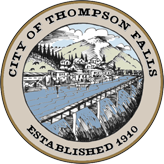The Place:
Originally just Thompson, Thompson Falls was named in honor of fur trapper David Thompson, one of the best known explorers in the Northwest, the first person of European descent to enter many areas. A Canadian in the employ of the British North West Company, it was his job to establish trading posts for the purpose of obtaining furs for the company by trading with the natives. In 1809 he established
Saleesh House, the second trading post to be constructed in what is now Montana, about five miles east of here near the confluence of the Thompson and Clark Fork Rivers.

Though the railroad arrived in 1881 and a town site was platted in 1885, it was not until 1910 that the town of Thompson Falls was established. When gold was discovered in the nearby Cœur d'Alene area in 1883, Thompson Falls grew as a supply post, but it was the construction of the
Thompson Falls Dam, beginning in 1911, which supplied the town with a substantial economic base.
The seat of Sanders County, Thompson Falls has about 1,350 friendly residents. Rich in history, and preserving their local heritage, the city has many historic sites and buildings to explore. Stretching along the north side of the Clark Fork River, immediately opposite the Thompson Falls Dam and hydro station, Thompson Falls seems a somewhat sleepy little town content to bask in the natural beauty of the falls, the river and the mountains which surround it.
An interesting fact about Thompson Falls is its natural refrigeration. Crevices in the ground here emit air cooled by the earth to temperatures as low as 33° Fahrenheit. These currents were once used by businesses of the town to supply refrigeration. It's doubtful that this refrigeration method remains in use today.
Though the town has a number of National Historic houses and buildings, the city hall is not one of them. Relatively new, the bungalow style building has a steel roof, copious stonework on the street side and blue painted hardboard siding. It stands on the west side of Fulton Street, a block south off the main drag, AKA Highway 200. It is near the centre of the commercial section of Thompson Falls, an area about twelve blocks long and two blocks deep, with the much larger residential area of town across the highway to the north.
The Person:
David Thompson
fur trader, explorer, surveyor, justice of the peace, businessman, and author; b. 30 April 1770 in the parish of St John the Evangelist, Westminster (London), son of David and Ann Thompson; d. 10 Feb. 1857 in Longueuil, Lower Canada.
David Thompson’s origins were humble, his final years spent in poverty, as an explorer and surveyor, his work has earned him a reputation as one of the best pioneering geographers in North America.
He was ... enrolled in the Grey Coat mathematical school, where he received a rudimentary training in navigation, and on 20 May 1784 he was apprenticed to the Hudson’s Bay Company for seven years.
Thompson was sent inland in the summer of 1786, and in September he left Cumberland House (Sask.) with Mitchell Oman, an able but illiterate Orkneyman, and 13 others to establish South Branch House (near Batoche) on the South Saskatchewan River. At Cumberland House the following summer he appears to have perfected a working knowledge of the Cree language, an essential skill for a prospective fur trader in that region.
He passed the winter of 1787–88 with Peigan Indians in the Rocky Mountain foothills and learned their language. Back at Manchester House in the fall of 1788, he seriously fractured his right leg on 23 December in a sled accident. Severe swelling made it impossible for the leg to be set properly, so it healed slowly... By the end of the summer of 1789 he had regained enough strength to move around with the help of crutches.
By spring Thompson had arrived at his momentous decision to leave the HBC for the NWC, and on 23 May 1797 he set out from Bedford House to walk to Alexander Fraser*’s post on the Reindeer River.
The NWC was concerned about the implications of the successful American overland expedition to the Pacific coast, led by Meriwether Lewis and William Clark in 1806, and was anxious to determine whether the Columbia River could be used as a gateway to its trading territories... over the next three years he extended his trade and surveys throughout the territory of the Kootenay Indians and south into the Flathead country, passing the first two winters at Kootenae House near Lake Windermere, and the third winter at Saleesh House (near Thompson, Mont.). Thompson successfully precluded the expansion by American traders into the area. But in doing so he had seriously undermined the position of the Peigan Indians as intermediaries in the trade across the mountains and created tensions that came to a head in 1810.
Read on at Biographi Canada